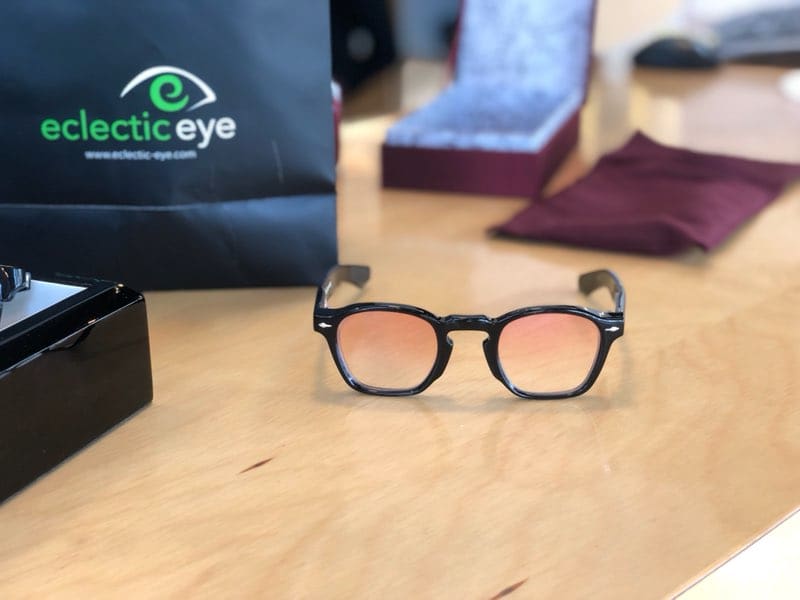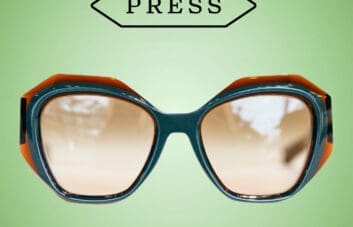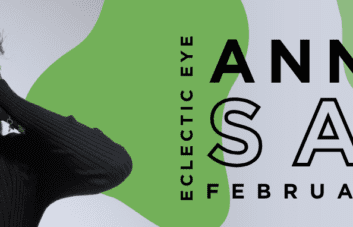Eclectic Eye customers enjoy the experience they receive from our staff when selecting their new glasses. We try to make the experience fun and entertaining every time they stop by, because why should it be boring? Many customers are selecting a necessary accessory that you will wear all day, every day for the next year or even longer, so we want to make sure you have chosen wisely. Our staff members know the inventory inside and out and how each, hand-selected piece will work on your face. Most importantly, we know what will work best with your prescription.
 After the customer has picked out their brand-new pair of exceptional glasses, the process has only just begun. The prescription lenses need to be ordered, received, inspected and created right here in our in-house lab. From there, the order is inspected again by the eyewear architect who helped you, then gently packaged in its custom case and bag and supplied with the necessary accouterments, like a cleaning cloth and cleaner. Lastly, an additional appointment is set with the eyewear architect and the patient to pick up their new eyewear. Depending on the prescription and the use of the new glasses, the amount of time needed for a dispensing appointment can vary from 10 minutes to 30 minutes. We like to allot a good amount of time for the dispensing, as we view that just as important as the selection process.
After the customer has picked out their brand-new pair of exceptional glasses, the process has only just begun. The prescription lenses need to be ordered, received, inspected and created right here in our in-house lab. From there, the order is inspected again by the eyewear architect who helped you, then gently packaged in its custom case and bag and supplied with the necessary accouterments, like a cleaning cloth and cleaner. Lastly, an additional appointment is set with the eyewear architect and the patient to pick up their new eyewear. Depending on the prescription and the use of the new glasses, the amount of time needed for a dispensing appointment can vary from 10 minutes to 30 minutes. We like to allot a good amount of time for the dispensing, as we view that just as important as the selection process.
The Dispensing Appointment
During the dispensing appointment, we make sure that the customer’s vision is crisp and clear. We check to make sure that the frame fits comfortably on your face and not going to move anywhere when wearing. This process typically requires a few minutes of adjusting the frame to fit your face precisely, because everyone’s face is shaped a bit differently! Sometimes, the appointment might involve optical education on how to wear the new glasses and lenses. For example, if this is the patient’s first time wearing glasses or maybe their first time wearing bifocal lenses, we show you how they work once you try them on. We check all fields of vision, the distance vision for watching television or driving, the intermediate for the computer focal length and near vision for reading.

Prior to ordering the glasses, the eyewear architect asks a lot of questions about the patient’s current glasses and prescription. This helps give us insight into how to best fit your new glasses. During the selection process, we notice how you prefer to wear your current frames. For instance, maybe you like to have your glasses fit as close to your eyes as possible, or maybe you like them to sit a little further away from your eyes and down on your nose, because that is where the frames feel the most comfortable on you. All of that is ok! This is what we call “position of wear.”
Many times, patients have multiple frames for multiple types of activities, which will result in different positions for each pair. If you are looking at specialized monitors at your job, we will want to accommodate the adjustment to meet that particular angle. Perhaps you play a certain instrument and need a specific adjustment to accommodate the instrument and sheet music. These are all things that help us determine the optimized set of glasses for you. We also look at the current glasses, check to see where you have been wearing them and make sure your new lenses are customized for this position. We like to measure twice and cut once. All of this should come together during the dispensing appointment.
The eyewear architect will review how to protect the patient’s new eyewear investment by showing you how to properly care for your frames. Never use Windex, 409 or other harsh chemicals to clean the lenses or the frame. Those products contain ammonia, which can strip protective coatings off of spectacle lenses, and sometimes the harsh chemicals can oxidize the frame, causing discoloration. We will review a few reminders  like what to do when hairspray gets on your lenses and will not come off with lens cleaner and issues that fabric softener can have on lenses. Fabric softener creates a chemical reaction when activated and creates the pilling or tiny little balls on clothing which can scratch a lens. This is the main reason we are always telling you not to clean your glasses with your shirt! We give you lens cleaner and cleaning cloths with your new eyewear purchase to encourage the use of it.
like what to do when hairspray gets on your lenses and will not come off with lens cleaner and issues that fabric softener can have on lenses. Fabric softener creates a chemical reaction when activated and creates the pilling or tiny little balls on clothing which can scratch a lens. This is the main reason we are always telling you not to clean your glasses with your shirt! We give you lens cleaner and cleaning cloths with your new eyewear purchase to encourage the use of it.
 A dispensing appointment might sound like a lot of work, but we think it’s critical to setting up our customers with successful use and enjoyment of their frames.
A dispensing appointment might sound like a lot of work, but we think it’s critical to setting up our customers with successful use and enjoyment of their frames.
By: Randall Bennett, LDO, Eyewear Architect




